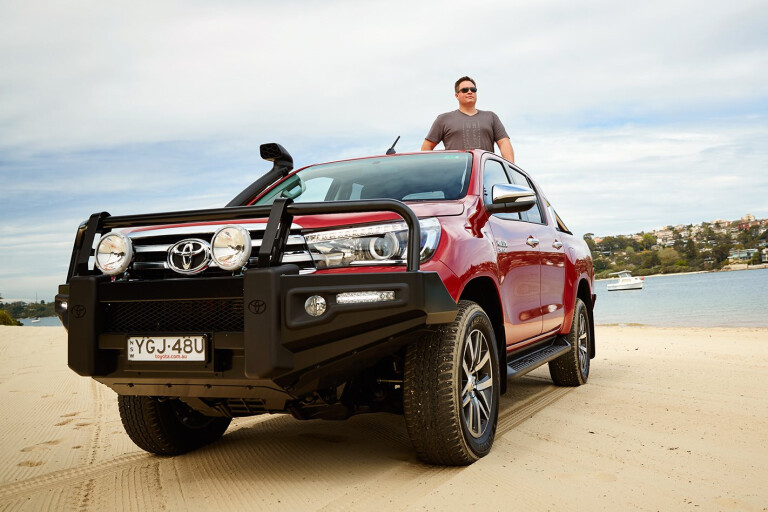
- Part One: Taking One For The Team
- Part Two: No Load Too Small
- Part Three: Bumpy Business
- Part Four: On The Road
Part One: Taking One For The Team
No, we haven’t gone mad here at Wheels, at least not yet. But we have decided to do something we’ve never done before – live with a ute.
We’re not interested in shovelling dirt or working out what’s the best rig for a tradie looking to save a few bucks. Nope, we’re heading to the other end of the market, the dual-cab four-wheel drive loaded with fruit. It’s a booming segment, to the point that Mercedes-Benz is following an SUV-like trajectory into luxury.
For now, though, the Toyota Hilux continues to lead the pack, and this year it’s even in with a shot of becoming the first ute to top the market. Many a Falcon and Commodore driver has traded in their sedan for something with less finesse and a lot more carrying capability.
Perhaps it’s no surprise. Most dual-cabs can now tow 3500kg (the Hilux can, although auto versions are limited to 3200kg). You can option them with leather and all manner of accessories, and dual-cabs can carry five people. But are they worth the $60K-plus spend? That’s what we want to find out.
In what some Wheels readers may see as a cruel experiment, we’ll spend four months with a Hilux SR5; everything from regular driving and family duties to some freeway runs and, possibly, the occasional gravel escapade.
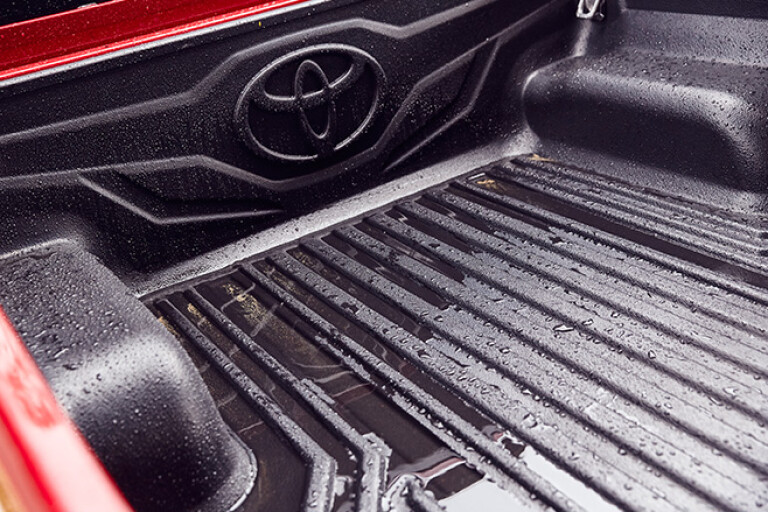
The SR5 comes with satellite navigation, digital radio, climate control and a 7.0-inch touchscreen. There’s also smart-key entry, although it’s not the grab-the-handle-and-go type; instead, you press a button on one of the front door handles to unlock the doors.
Unlike some rivals, the Hilux has reach and rake adjustment for the steering, although the seating position is still quite upright – and high – thanks to the ladder-frame chassis underneath.
An electric driver’s seat and leather are part of the $2000 Plus pack while the auto adds the same again. Ours also arrived with some extra off-road fruit: a snorkel ($685); steel bull bar ($2493); driving lights ($793); and a towbar with trailer brakes ($906). Metallic paint adds another $500 and a plastic tub liner $450 for a total of $63,311.
Yet it’s missing the active safety still rare in this part of the market and gets only single-zone climate control.
While the SR5 is available with a 4.0-litre petrol V6, it’s the diesel that’s the big seller. The 2.8-litre four-cylinder turbo is all-new, replacing the previous 3.0-litre unit. Peak outputs are nothing special and are easily beaten by others in the class. Power is a modest 130kW, while torque is closer to the money at 450Nm.
Our SR5 arrived with just 631km on the odo, so it might need a few more miles under its 18-inch alloys to reach its best.
Power is channelled through a six-speed automatic transmission, our weapon of choice for this test, or a six-speed manual (with 30Nm less). We love our stick shifts here at Wheels, but let’s face it, a Hilux is not the sort of car in which you’ll be chopping through the gears on the back way to the office.
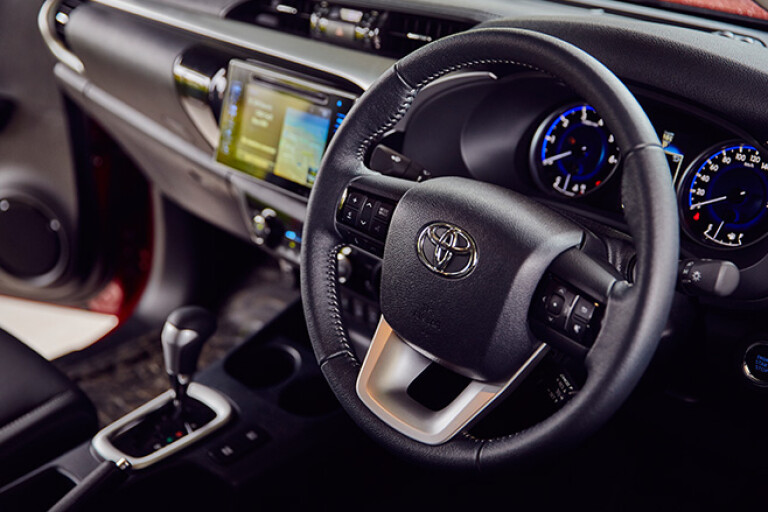
We learned that early on. This thing is more truck than car, right down to its lacklustre steering and tendency to bounce around over bumps. Workhorse utes are never delightful things unladen, but the Hilux is particularly taut in its tail thanks to leaf springs designed to cope with more than a tonne in the tray. And the snorkel adds to induction noise on part throttle, which provides a hint of character if not much in the way of punch.
Still, there’s something refreshing about being able to tackle speed humps, and not having to worry about ripping the front bumper off on steep driveways. Or scraping a rim when parking.
The Hilux certainly feels tough. Unbreakable, right? Let’s find out.
TOUGH AT THE TOP
Until recent times, the Hilux dominated the ute segment in Australia. That’s been eroded by increased competition, predominantly from the Ford Ranger, which has gone from an also-ran to challenging Toyota for sales supremacy in the 4x4 segment. To the end of September this year the Hilux was still the sales leader — just. But it was the tradie-focused stripper models keeping it on top of a hard-charging pack.
POWER FOR THE PEOPLE
Get ready for utes with more grunt. VW has added a V6 variant to its updated Amarok (with 165kW/550Nm, it’s the most powerful in class), Ford is working on a Ranger Raptor, and HSV on a Colorado.
Toyota was first to test the waters with its Hilux TRD in 2008; a supercharged 4.0-litre V6 petrol lacked nothing for grunt, but getting it to the ground made for lairy sideways moments. Now Toyota is working on something to sit above the SR5, with the TRD name a strong chance to be dusted off.
Part Two: No Load Too Small
Remember when phones were about making calls? And utes were about carrying things?
In this modern connected world, phones seem more about playing music and games, watching cat videos, grabbing an Uber, or helping us not go around in circles. And utes are about loading up the family, towing caravans and carrying surfboards – among other things. Yet this month I learnt all about what utes can actually lug.
It started with a couple of trips to the tip to offload the remains of a hedge that had decided to grow every which way but the direction I wanted. Then there was a bunch of beds and mattresses as part of a toddler shifting into a big bed (said toddler loves “the yoooot”, by the way).
Next was a wine fridge, easily slid across the optional ribbed plastic tray liner and lashed to the corner mounting points with a tie-down.

But it was the trampoline that was the most ambitious Hilux carry. The prospect of delicately wheeling this newly acquired 10-foot tramp from a neighbour’s house to mine simply wasn’t on the cards. So onto the back of the Toyota Hilux SR5 it went.
It wasn’t entirely within the confines of the four-door body, but with some tie-downs in place the trampoline was soon on its way, albeit unlikely to appease any of the establishment’s finest had they seen my somewhat optimistic loading.
That’s part of the beauty of having a ute; being able to throw whatever you want at it. Besides, it got the job done, to the point where I’m now on the hunt for other things to launch into the Hilux’s tray. Mountain bikes seem far too simple a task, although it’s the most common addition to my SR5.
I’ve learnt plenty about the appeal of the functionality and practicality that makes the Hilux the weapon of choice, even when there’s a perfectly normal passenger car alongside it in the garage.
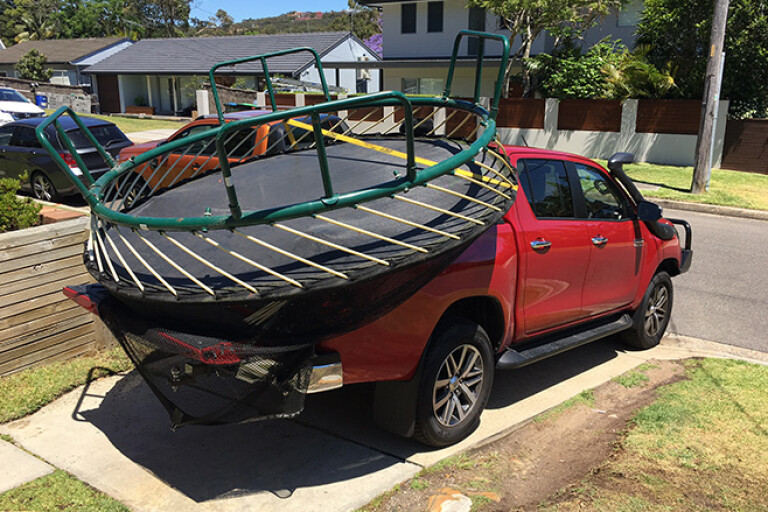
Digital radio is a win, too, although it’s a shame the head unit has frustrating touch buttons for the volume. Combined with more buttons on the wheel, it means lots of pressing to make big adjustments.
The Hilux’s on-road manners also aren’t as endearing as its carry-anything attitude. Those wanting the poise of a BMW X5 or Ford Territory ought to look elsewhere for their cornering fix. The steering is overly light and vague, and the 18-inch Dunlop Grantreks are prone to yelp if you arrive at a roundabout with too much enthusiasm.
The firm rear leaf springs are able to carry almost a tonne without strain, but they lack compliance for everyday unladen duties.
Perhaps it’s time I loaded something really heavy in the back to tie the thing down…
The weakest link
Hilux’s legendary ‘unbreakable’ toughness didn’t get off to the best start. Early on, the flimsy rubber cover that conceals the USB port when you’re not charging a fandangled smartphone tore off as I was removing the charging cable. Of course it has nothing to do with operator error; I blame poor design… Seriously. And I guarantee it’s not the only Hilux to lose what is a fairly useless item in the otherwise well-presented interior.
Part Three: Bumpy Business
UTES are more than just a way to get around. They’re a lifestyle, one that’s built an almost cult-like following with some of the more hardcore fellow ute owners.
And I’ve learned more about Club Ute in recent weeks, having covered plenty of predominantly city kays, where utes are prevalent.
There’s a ute peak-hour (it’s over by about 7.45am and kicks off again at 2.30pm) and a general ute understanding in traffic.
And it pays dividends when dicing for a gap on clogged roads.
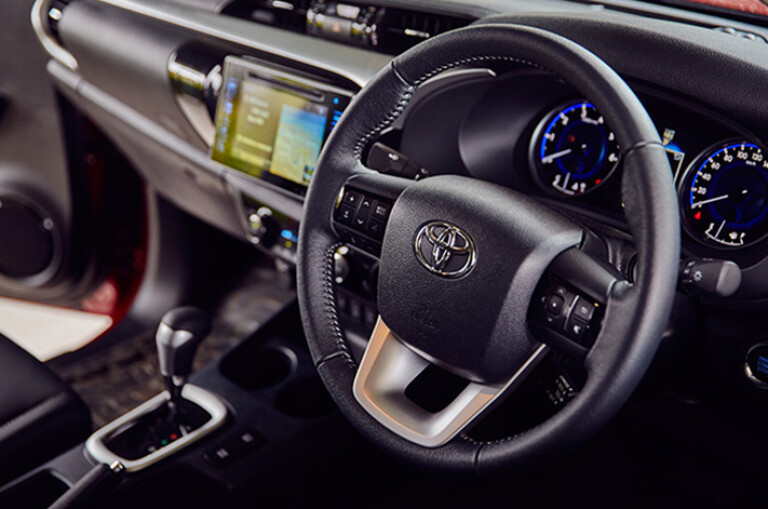
Ute-to-ute is so much easier when merging, with merely a glance to acknowledge such courteousness (although, then again, it could be the sheer bulk of the Hilux – bullbar, snorkel and all – that creates openings that didn’t exist moments earlier).
The ute respect works much better in identical vehicles. Spot another Hilux SR5 and I’m almost certain to get a sideways glance and a steady but deliberate raise of a finger off the steering wheel.
But it’s the ability to launch anything at the tray whenever you want that’s the biggest ute win. This month it was a woodfired oven to practice my pizza-making.
The full 300kg disaster was forklifted into the back of the Hilux, where it was a fraction too wide to snug down between the inner wheel arches.
All that extra weight in the tail softened the ride just enough to make it borderline comfortable, adding a healthy dose of compliance to the rear end. And the 450Nm felt almost as strong as ever, comfortably lugging from its 1600rpm peak.
The wooden crate in which said oven was packed dug hard into the extra-cost-option plastic tray liner, but it flexed back into shape once the delicate job of removing the load had been achieved at the other end.
I’m less enamoured than ever with the Hilux’s unladen suspension behaviour, though. The rear end bucks around and does nothing for general comfort levels, which becomes an issue over bumpy roads with the family on board. The kids somehow think it’s fun, the missus less so.
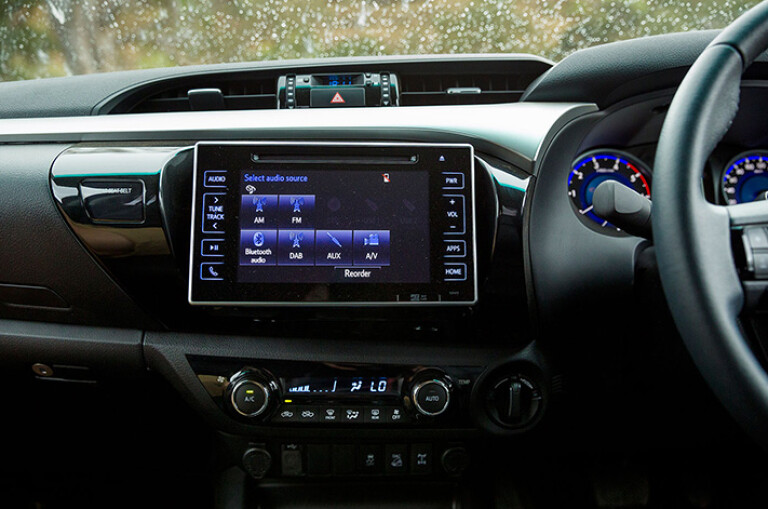
Points are made up with the digital radio tuner, although the speakers are terrible; any hint of bass and they start woofing and croaking. A $60K car laced with leather should have a better sound system than this.
Then there’s the touchscreen, which continues to be a source of frustration when it comes to big volume adjustments and flicking between stations.
Overall, though, the Hilux is a welcome addition to the garage and one that continues to get regular use as a family car, around-town runner and light-duty hauler.
Part Four: On The Road
Utes are great at carrying things but not particularly good at keeping said items out of the weather. Such was my last-minute realisation when planning an interstate trip in our Toyota Hilux – a final fling before the SR5 made its way back to Toyota HQ.
With a family and luggage on board, it was typical of the average holiday usage for a ute. Big kays, fervent over-packing and kids who wished they’d arrived before they’d clipped their seatbelts.
Just finding somewhere for our piles of luggage and Christmas presents proved something of a challenge. Despite the cavernous tray, utes don’t provide many decent in-cabin options for stashing things. The Hilux’s twin gloveboxes and centre console are about it.
Fortunately, a friend suggested we buy some plastic tubs and load them with our gear before strapping them in the back. It proved a top idea, ensuring we had more room in the cabin for four people, snacks and toys to keep the kids content.
So it was off on a 2000km, four-day interstate road trip that was more bland freeway than snaking country roads.
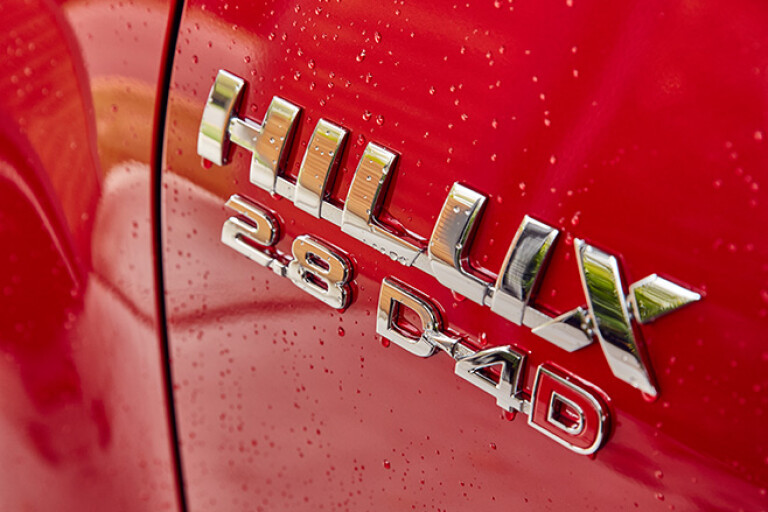
A quick check using a GPS app on the phone showed the Hilux was about 5-6 percent optimistic, so there was some room to move at the 110km/h indicated speed.
A few hundred kays in and it was clear the best the Hilux was going to do was about 650km from its 80-litre tank. The fuel gauge is quite pessimistic; over four months, the most I ever squeezed in with the needle below E and the fuel light glowing was 64.4 litres, suggesting there was still 150km of driving in the tank. Not that I wanted to test it.
Even then, the best we posted was 9.9L/100km. That’s still better than the mid-12s we’d been getting around town, but not as low as I’d hoped for freeway motoring. No doubt the weight and aerodynamic drag of the bullbar and snorkel wasn’t helping.
Another thing not helping on bumpier surfaces was the ride. The Hilux is super firm and after four months it’s clear it works better with a few hundred kilos on board. That extra weight is enough to settle the stiffly sprung rear-end and give it some much-needed compliance. Most of the Hume is pretty smooth, but there’s a section south of Albury that keeps things jiggling unpleasantly.
Otherwise, the Hilux is a decent way to travel. Keep the engine at lower revs and it’s quiet and otherwise comfortable, loping along nicely with the cruise control engaged. Just don’t expect a whole lot in the way of excitement.
Despite its flaws, living with a ute has been thoroughly enjoyable. It’ll carry almost anything, devour speed humps and cop all manner of punishment in the process. All of which I’ll miss.
COMMENTS